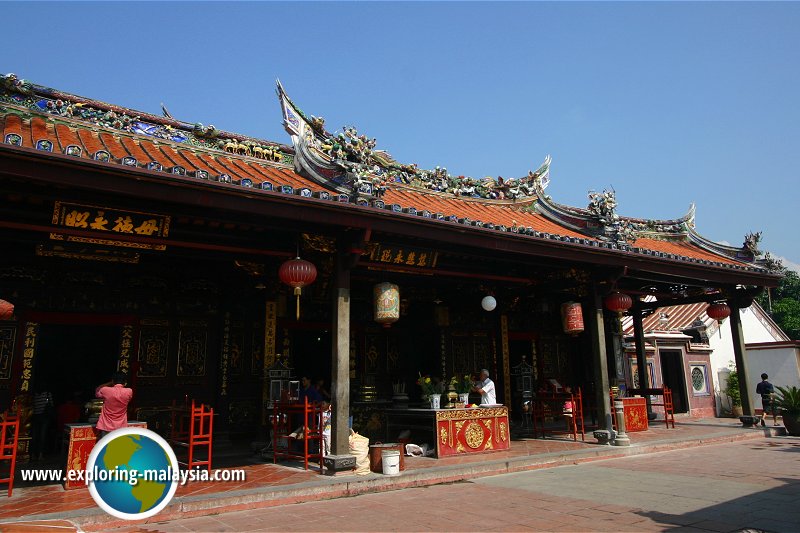 Cheng Hoon Teng Temple, Malacca (11 July, 2005)
Cheng Hoon Teng Temple, Malacca (11 July, 2005)
Cheng Hoon Teng Temple (GPS: 2.1975, 102.24697) at Jalan Tokong, Malacca, is the oldest and surely one of the grandest Chinese temples in Malaysia. Apart from the Tanjung Tuan Lighthouse, which was originally built in 1528 but the present structure dating to 1863, the Cheng Hoon Teng stands as perhaps the oldest structure in continuous use in the country.
With its curved roof ridge, cut-and-paste chien nien decoration, and gable design, the Cheng Hoon Teng reflects the architectural style of South China, of craftsmen from Fujian and Guangdong. It has recently been restored, and in the process garnered a prestigious UNESCO award for outstanding architectural restoration. At the time of my visit, in July 2005, it still glimmers with the newness of the restoration work.
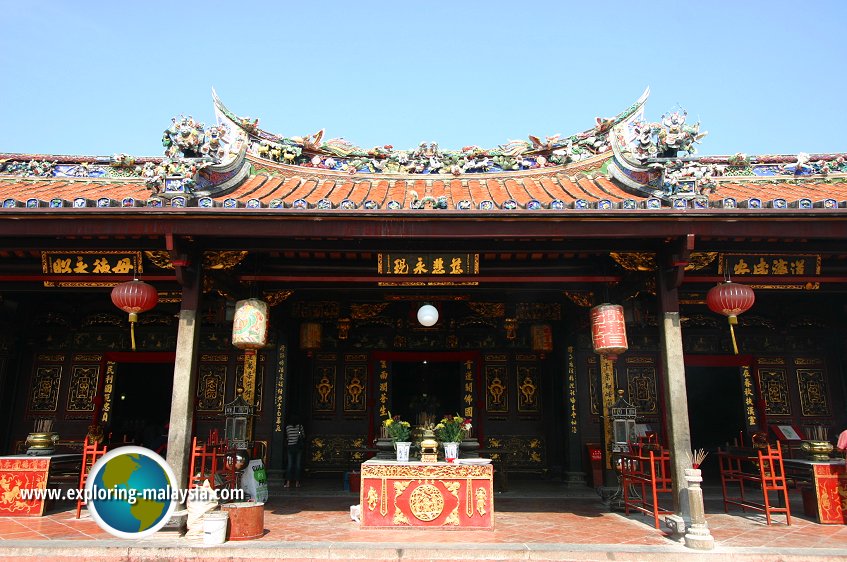 Cheng Hoon Teng Temple, Malacca (11 July, 2005)
Cheng Hoon Teng Temple, Malacca (11 July, 2005)
Cheng Hoon Teng, which means Temple of Clear Clouds, was founded in the early 17th century (not sure exactly when, but some say 1645) by the Kapitan China Tay Kie Ki alias Tay Hong Yong. In addition to being the religious institution, the temple also served as the official administrative centre and court of justice of the Kapitans, which included Li Wei King, Chan Lak Kua and Chua Su Cheong.
One side of column in the entrance employs Cao-shu, a grass script style of Chinese calligraphy which was done by Robert van Gulik (1910-1967), a Dutch diplomat and authority on Chinese history and culture.
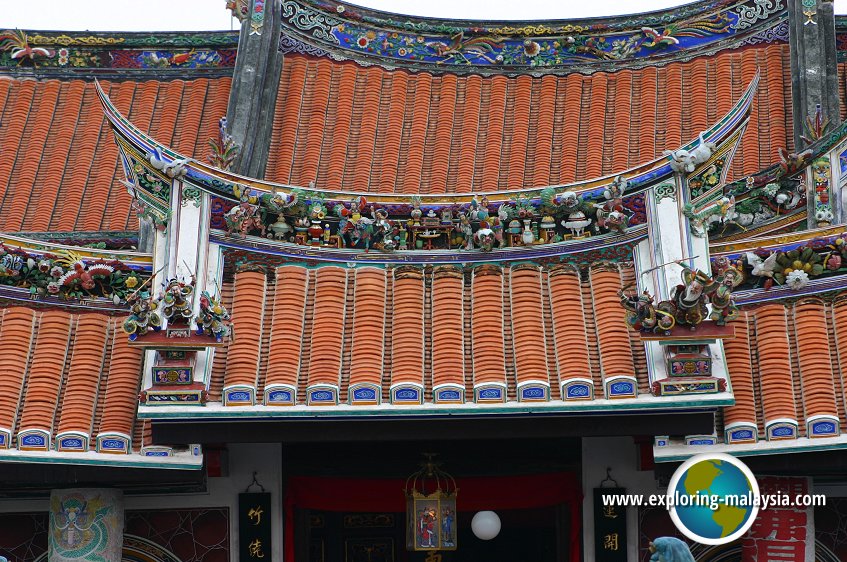 Details of the curving roof ridges and broken-porcelain ornamentation (chien3nien2) at Cheng Hoon Teng Temple (11 July, 2005)
Details of the curving roof ridges and broken-porcelain ornamentation (chien3nien2) at Cheng Hoon Teng Temple (11 July, 2005)
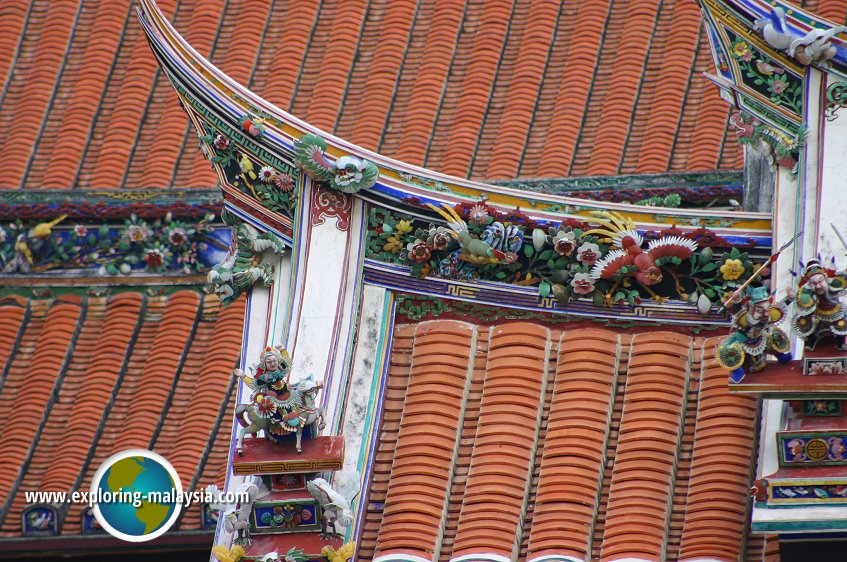 Details of the roof ridge ornamentation, Cheng Hoon Teng Temple (11 July, 2005)
Details of the roof ridge ornamentation, Cheng Hoon Teng Temple (11 July, 2005)
The main hall was first constructed in 1704 by Chan Ki Lock, and was rebuilt by Kapitan China Chua Su Cheong in 1801. The central altar is dedicated to Kuanyin, the goddess of mercy. To her left (in the worshippers' direction) is Ma Choo @ Ma Choe Poh, patron diety of fishermen, sailors and sea travellers. Next to her is the goddess of birth. On the far end is Kuan Kong. The diety with the gold face is Pau Sen Ta Tek, the god of welding.
Unlike other Chinese temples, the Cheng Hoon Teng does not employ door gods. Instead the doors are guarded by the famous Taoist monks, The Eight Immortals. At the outer gate are the Eight Immortals on the animals that they ride on. At the entrance to the main hall, the Eight Immortals are no longer shown as humans, but are instead symbolized as dragons with four claws. Within their claws are the Eight Immortals' instruments, namely the flute, knife, lotus and fan. These dragon representations are called Ar Enn Pak Sien, or Hidden Eight Immortals.
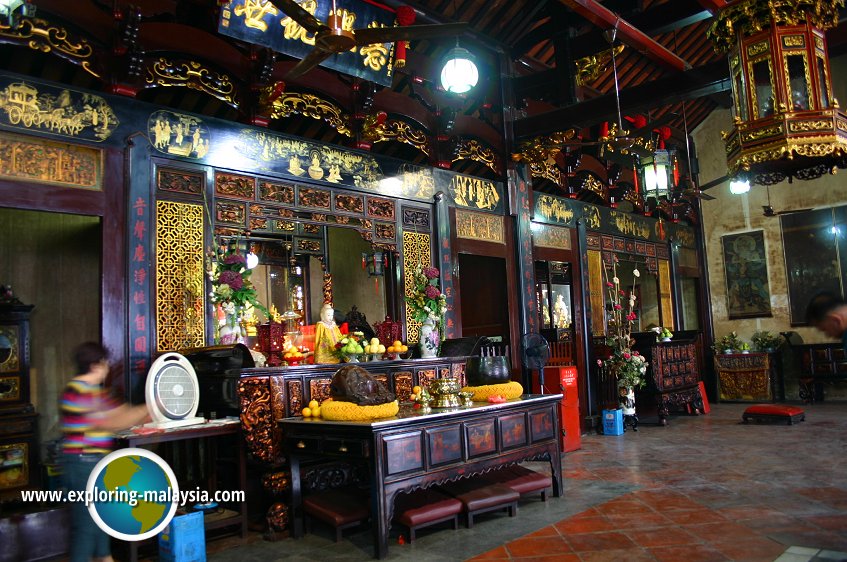 Prayer hall of Cheng Hoon Teng Temple (11 July, 2005)
Prayer hall of Cheng Hoon Teng Temple (11 July, 2005)
[an error occurred while processing this directive] On the walls are the Eighteen Lorhans, now encased behind glass. Their depictions have almost disappeared under centuries of smoke. On the outside of the main hall are columns with gold calligraphy in cao-shu, a grass style script. It was written by Robert van Gulik (1910-1967), a Dutch diplomat and authority in Chinese culture and history.
Within the grounds of the Cheng Hoon Teng are stelae, stone tables commemorating special events. A lot of travel books as well as Internet sites mention that there is a stone inscription here that was brought by Admiral Cheng Ho. Probably what Cheng Ho brought was similar, but the stelae in Cheng Hoon Teng Temple are definitely not the stone inscription brought by Cheng Ho. Due to similarity when transcribed into English - the Cheng in "Cheng Hoon Teng" and "Cheng Ho" sounds the same in English, but are different words in Chinese.
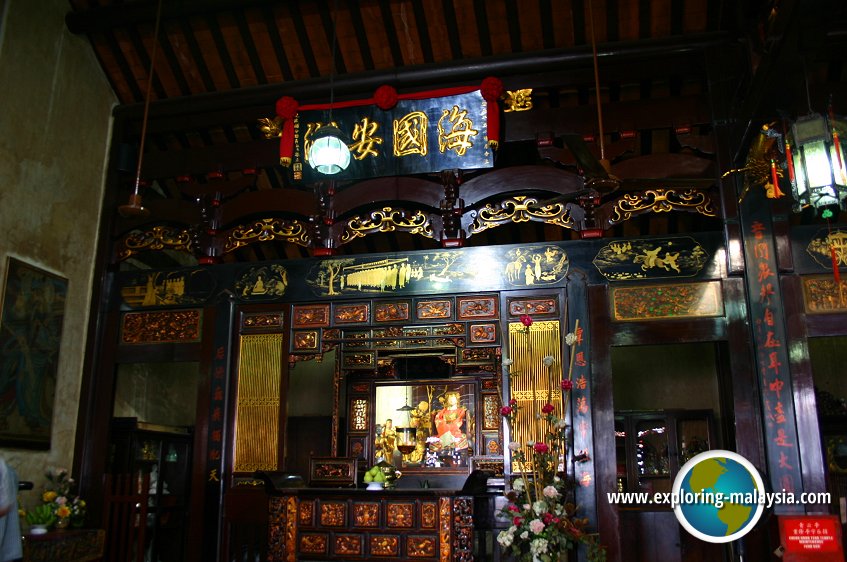 An altar at Cheng Hoon Teng Temple (11 July, 2005)
An altar at Cheng Hoon Teng Temple (11 July, 2005)
The oldest relic in the temple is the stela dating to 1685. It is in fact a thank you note to Kapitan China Lee Wei King, commemorating his donating of a piece of land to the Chinese community for the purpose of a Chinese burial ground. This burial ground of course refers to the one at Bukit Cina, which has no connection with Cheng Ho whatsoever.
The way of depicting year, as appearing on the stone tablet is now no longer in use in present-day Chinese. Instead of following a numerical numbering of years, the Chinese at that time calculate the year in accordance to the reign of Chinese Emperors, of which each emperor's reign carries a specific name. Around 1685, when the tablet was carved, it was Qing Dynasty (1644-1911), when the Manchurians ruled over China. But the Han Chinese refused to acknowledge the Manchurian emperors, considering Manchurians and everybody else barbarians. Hence, instead of representing the year according to the Qing Emperor's reign, the stone inscription stated that "the dragon has flown", meaning it is after the Ming Dynasty.
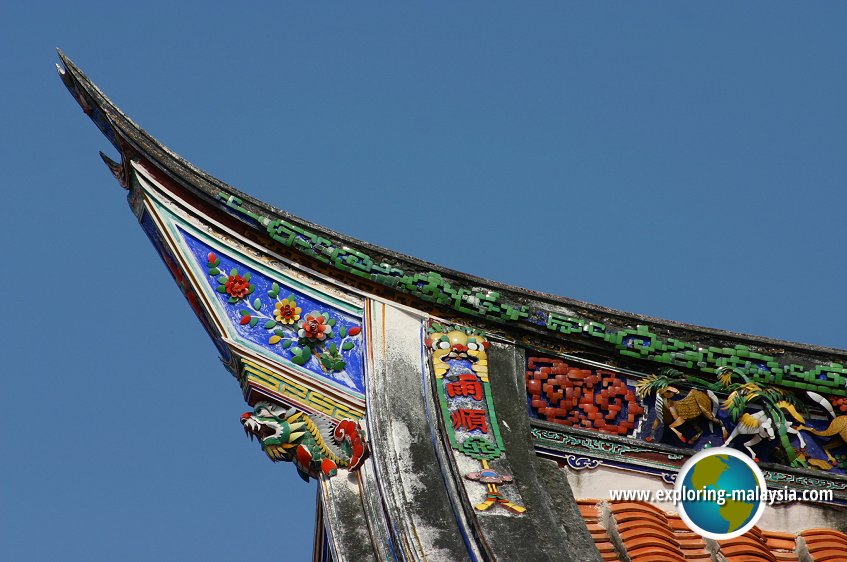 Roof ornamentation at Cheng Hoon Teng Temple (11 July, 2005)
Roof ornamentation at Cheng Hoon Teng Temple (11 July, 2005)
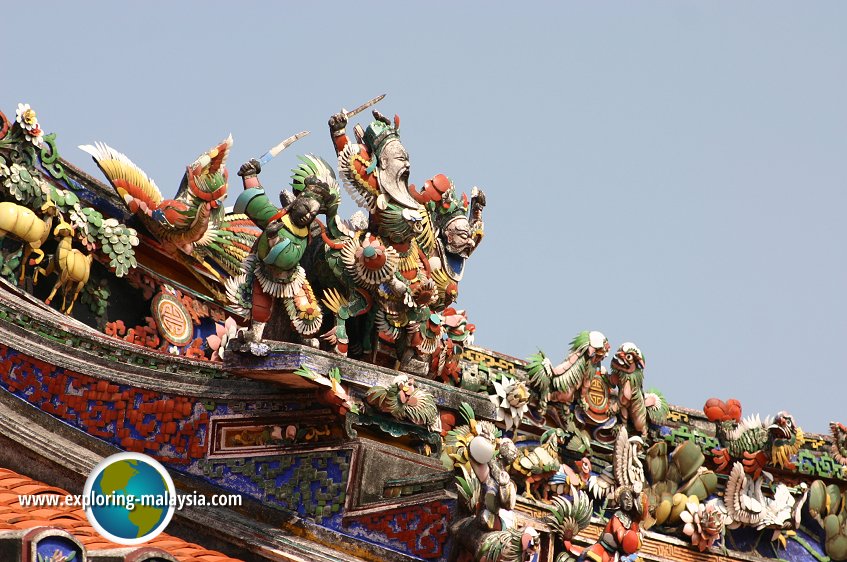 Figurines of broken porcelain (chien3nien2) at Cheng Hoon Teng Temple (11 July, 2005)
Figurines of broken porcelain (chien3nien2) at Cheng Hoon Teng Temple (11 July, 2005)
The walls of the temples are all painted with limewash. In the olden days, lime was used instead of cement. Everything was derived from natural sources. The lime comes from the oyster shells and soot from charcoal.
During my three-day trip to Malacca, I visited the Cheng Hoon Teng Temple three times, to get the necessary shots for this website. On my second visit, with AsiaExplorers members, we were shown around by Josephine Chua, who gave us a very detailed description of the temple. I want to take this opportunity to thank Josephine for taking time to take us around.
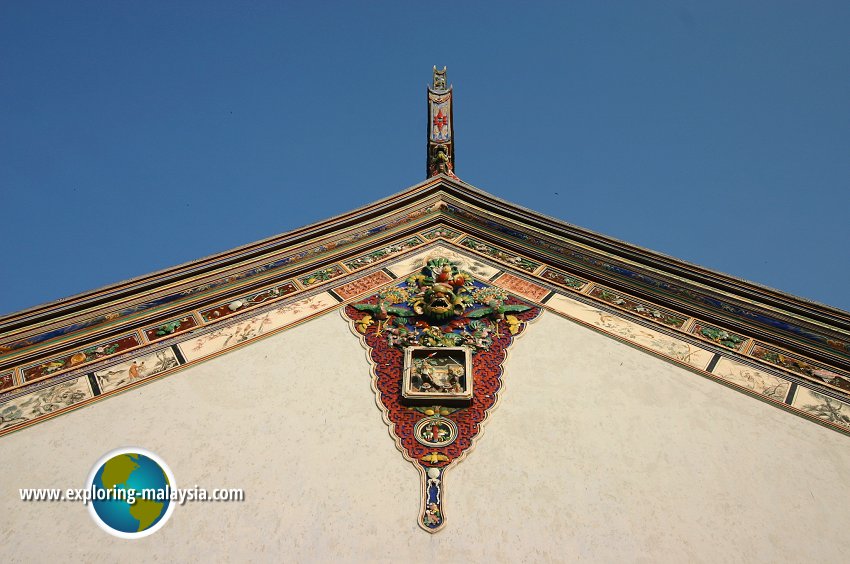 Ornamented gable at Cheng Hoon Teng (11 July, 2005)
Ornamented gable at Cheng Hoon Teng (11 July, 2005)
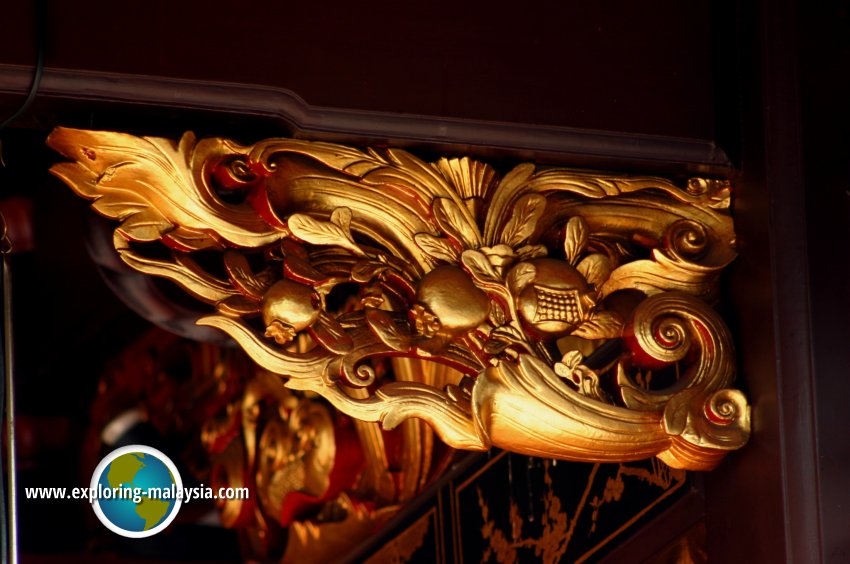 What looks like gold, is. (11 July, 2005)
What looks like gold, is. (11 July, 2005)
Cheng Hoon Teng Temple is  on the Map of Chinese Temples in Malacca
on the Map of Chinese Temples in Malacca
Cheng Hoon Teng Temple is  on the Map of Malacca
on the Map of Malacca
Discover Malacca; list of Chinese Temples in Malacca and Chinese Temples in Malaysia
 Latest updates on Penang Travel Tips
Latest updates on Penang Travel Tips
 Discover with Timothy YouTube Channel
Discover with Timothy YouTube Channel
 PG Food Channel
PG Food Channel
 Learn Penang Hokkien YouTube Channel
Learn Penang Hokkien YouTube Channel
 SojiMart Videos
SojiMart Videos
Latest from Discover with Timothy: Gurney Bay - what to see and do there
About this website

Hello and thanks for reading this page. My name is Timothy and my hobby is in describing places so that I can share the information with the general public. My website has become the go to site for a lot of people including students, teachers, journalists, etc. whenever they seek information on places, particularly those in Malaysia and Singapore. I have been doing this since 5 January 2003, for over twenty years already. You can read about me at Discover Timothy. By now I have compiled information on thousands of places, mostly in Peninsular Malaysia and Singapore, and I continue to add more almost every day. My goal is to describe every street in every town in Malaysia and Singapore.
Robbie's Roadmap
- Episode 1: Robbie's Journey to Financial Freedom
- Episode 2: Lost in America
- Episode 3: The Value of Money
- Episode 4: The Mentor
- Episode 5: The Thing that Makes Money
- Episode 6: The walk with a Billionaire
- Episode 7: The Financial Freedom Awakening
- Episode 8: Meet Mr Washington
- Episode 9: The Pizzeria Incident
Copyright © 2003-2024 Timothy Tye. All Rights Reserved.


 Go Back
Go Back